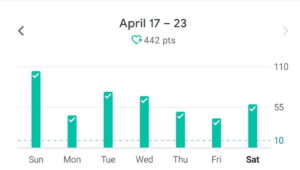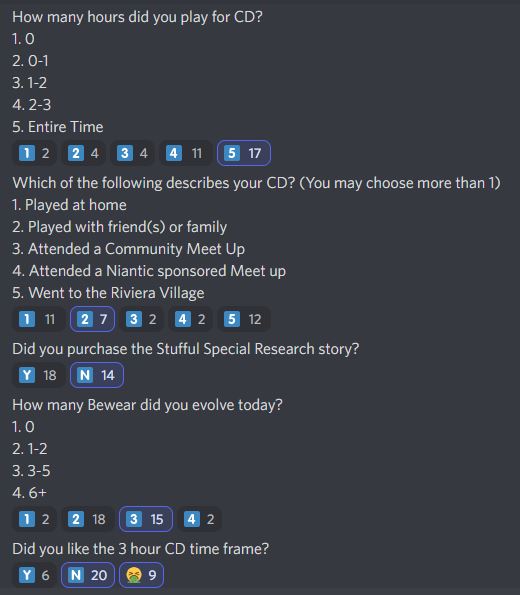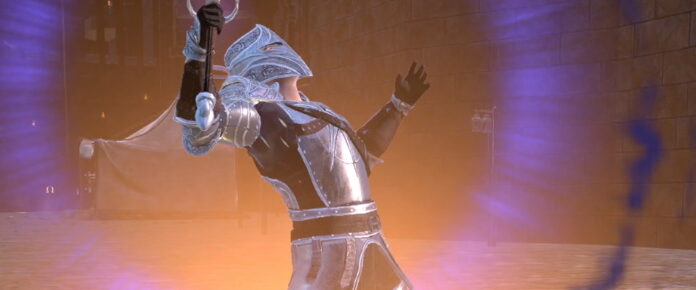
It’s judgment day for Niantic as Pokemon Go’s 2022 Community Day has now come and gone. As we’d noted, the studio was pushing a new Pokemon GO Community Day model against the expressed wishes of the broader community. I myself had severe doubts about the event, but I went in trying to be positive: I focused on reading positive experiences on social media the night before, gathered the friends who could make it, dressed the part, someone brought snacks, surprised someone with an early birthday gift, and had a good time.
But that good time was largely despite the event, not because of it. POGO was the background noise, and while my group loved the featured pokemon, the event model was not appreciated. Subjectively there was some good stuff, but objectively the event wasn’t great.
Telling the future from the past
I’m not the only one who’d vocalized that the “new” three-hour model we were being told to “try” was nothing new, just the company trying to recapture its pre-COVID glory days. However, Niantic loaded up bonuses, used a new pokemon with very high evolution costs, and pushed for real-life gathering, more so than it’s done for any other Community Day, all to prove that the data the devs intentionally misrepresented was proof enough to make the changes. They stacked the cards in their favor, and while I dislike being so negative, it still largely looked like a mistake.
Here’s what I thought would happen based on Niantic’s Community Day tweaks:
- Impact: Company goal of pushing exploration fails
- Impact: Company goal of pushing exercise fails
- Impact: Company goal of pushing socialization fails
- Impact: Fewer players active during event
- Impact: Collection of player walking data minimal
Each local community is different, so the results may vary. But if I’m as objective as possible, here’s what I saw.
Exploration took a hit for sure. While obviously some people went to the various hosted locations, the overall responses I saw online and in my communities said otherwise. Across all the groups I’ve personally played with, only one person wanted to go to a city event, and that group stopped organizing CD meets even before COVID. Even worse, car play was discussed more than walking, and that’s what happened the day-of. From the names in gyms and on lures, I knew there were many adults present, and many could be seen playing in their cars. Some people may have explored, though. There were a few new “faces” (I’ll get to that later), but I could identify many of the players who gathered physically, even if they were just in their cars. It probably didn’t help that the park isn’t just for playing POGO. There were kids’ soccer matches, people trying to walk their dogs, and a way-too-fancy-for-a-kid birthday party adding tons of garbage after I just cleaned the park for Earth Day, but more on this later.
 Exercise failed hard, and I have evidence via Google Fit, which Niantic syncs with to track my walking progress. I walked more during the Wednesday raid day, which I didn’t really participate in; I just walked a lot that day. My friends and I are motivated to exercise, so we did the shoehorned Cherubi event, mostly before CD started. We did almost no walking during, even though we knew there were quests, and it shows on Saturday’s lower results. The rush to get candy and shinies took away from that walking motivation for the first half of the event. We did a short lap, then walked a short distance to do a single raid, but overall you can see that I did less exercise than usual, and it was with friends who normally walk.
Exercise failed hard, and I have evidence via Google Fit, which Niantic syncs with to track my walking progress. I walked more during the Wednesday raid day, which I didn’t really participate in; I just walked a lot that day. My friends and I are motivated to exercise, so we did the shoehorned Cherubi event, mostly before CD started. We did almost no walking during, even though we knew there were quests, and it shows on Saturday’s lower results. The rush to get candy and shinies took away from that walking motivation for the first half of the event. We did a short lap, then walked a short distance to do a single raid, but overall you can see that I did less exercise than usual, and it was with friends who normally walk.
Socialization failed quite hard, at least in terms of meeting new people (assuming you were able to play at all). Lures do not make people talk to each other. Knowing someone else is playing doesn’t make people talk to each other. Being alone, being in a group, not a lot of that matters, especially as the game’s gotten older. Unless people need help or are looking to make new friends, they stuck to themselves or, like myself, with their usual groups.
I did physically see more players, but we didn’t really interact. We only spoke to one other player, as he needed help with the raid. The raid lobby had several familiar faces, but everyone kept their distance. No friendly “hey” or anything. As I’ve mentioned before, raiding is the major source of social play in this game. Despite setting up multiple lures and standing outside, I didn’t see any player-to-player interaction between groups. Towards the end, I may have seen a few people from a group that I had issues with, in person and in the raid, and at the end of the day, I sadly noticed my friends were also skimmed out of gyms in a way usually reserved for me, which was disheartening. However, most of the other players, to my knowledge, are not in that group, so I don’t think the lack of interaction was because of any drama. The main problem, as I stated, is that catching pokemon is a single-player activity, so it’s hard to use that to get people to socialize.
Let’s look at some data from one of my local leaders to discuss the player activity. To note, I did not participate in this group’s event. They offer a different perspective from a neighboring community, but all group members share their experiences in these surveys. Here are some of his numbers from past Community Day events:

Here are some numbers taken from the survey for Saturday’s controversial event, at 10:30pm local time, a whole 3.5 hours after all parts of the event had ended.
Notice how the total number of participants is fewer than Sandshrew’s event day, and Sandshrew is one of the very first pokemon the game got. The Alola one is old too, from 2018. About 29% of the players stayed at home at least part of the time, and Niantic’s sponsored event, which was only a few cities away from us, was not popular at all. Yes, over half the players paid for the event, and over half played the whole time, but a large majority strongly disliked the three-hour model.
Consequently, less participation and less walking means fewer data to collect.
It very much seems like, within my personal circles, my predictions were on target. The event wasn’t a total disaster, but Niantic very much stacked the deck in its favor and still failed to promote 3/3 of its company goals, failed to increase the overall player activity levels, and failed to generate increased data used for profits.
What’s worse, though, was that it didn’t have to be this way. The longer hours alone would have helped immensely. While I did notice there was an increased radius for the catch-xp bonus secretly advertised out of game, my crew didn’t want to waste the rapid spawn-safety of the lures they’d used, nor miss out on the bonus by going too far. However, not everyone used incense due to both the nerf and the fact that we were largely stationary, which further hurt the potential usefulness of the feature.
So many pieces were conflicting that, overall, the best part about the event wasn’t anything Niantic did differently; it was that it was one of the few days a month my friends could get together to hang out. We all love pokemon, and we love the motivation to get out, but we don’t need pressure to play more often or more hardcore. In fact, both the hours and style cut people out, and their presence was missed.
Niantic needs to remember that the players make Pokemon GO. It’s already a successful game. Pushing the players in the direction Niantic wants to go may just push people away, and in the long run, that has been doing more harm to the game than giving players what they’d already been asking for, just as with the COVID changes that greatly added accessibility to the game but Niantic sought to remove.
What this may mean
Niantic pulled out all the stops this month for Community Day, but it’s also launching a new game, Peridot. I don’t think that’s a coincidence. In fact, all things considered, I think Niantic has additional pressure to perform well, but whether that’s actually The Pokemon Company threatening to pull out or maybe Niantic considering going public with stock options, I have no idea. The desperation, though, is hard to ignore, especially with the heavy-handed marketing pushes, including last-minute a trip to Hawaii push and in-game advertising of the event every few hours the days leading up to it.
I’m not saying Pokemon GO is dying. Right now, I’m sure it’s fine. But it seems as if someone might be looking down the road at its end, and we’re experiencing tests to see how soon that may be. I could be wrong. Maybe some CEO is just messing with us all in some bet with a rival CEO. But the actions and results do not seem to be about making Pokemon GO a better game for anyone except a few narrow-minded people stuck in the past; after all, I’m sure some communities did well, especially those pretending that COVID numbers aren’t rising or that the virus hasn’t changed our lives.
The problem is that Niantic continually makes it difficult to trust it. I know my community experience isn’t the only one and some folks had vastly different experiences, especially at the sponsored areas. But those mega gatherings don’t represent the bulk of the playerbase, and many of the issues I noted are shared by others who attended them: the conflicting goals of the Cherubi walking event confusing the stationary lure-play of Community Day proper; meeting old players rather than new despite physically seeing new players; POGO players massing up in areas that the public at large was not expecting, often made worse in major cities where Niantic didn’t seem to coordinate; limited time cutting people out of the event entirely; raids being the primary multiplayer activity rather than simply catching. Across the spectrum, the player feedback and numbers I’m seeing don’t look great, and as Niantic only throws out fragments of data that align with its preferred narrative, I doubt I’ll trust any numbers it shares promoting what it’ll surely call a successful event.
By throwing everything into a singular event, Niantic let its flaws shine more than anything else. Its inability to properly get a group of social, adventurous Pokemon fans who are motivated to exercise to increase their engagement in any one of these “design pillars” should be a strong indication that Niantic should seriously reconsider who on the team is making gameplay/design choices going forward.
The use of older, previously released pokemon people could prepare made it possible for more exercise and more willingness to explore during past Community Days, especially because the company hadn’t hurt incense or asked us to stay near lures. Not only did the game see old problems like lack of participation due to hours or players crowding unprepared public spaces, but it also spawned brand-new ones, actively harming the game’s intended goals.
COVID-era Community Day may not have drawn crowds, but I saw it bring in more players overall, which led to more socialization, even during a time when we had to mask up and social distance. While it was online, I saw and experienced more people joining the game and searching for communities before. The last few three-hour events did the opposite; they pushed people away. It’s incredibly difficult to feel positive about Niantic in light of this, and simply reverting the hours and hardcore feeling shoved into the recent event won’t erase the fact that we’ve seen once again how poorly Niantic understands its own game and players.
4/25 Update: Niantic has announced the May Community Day, and while we’ll break up some of the mechanics during our May POGO event roundup, we’ll note here that it’s still quite similar to April’s mechanics. Alola Geodude is not a new pokemon, so that’s a small improvement, but the push for stationary play (rewarding stardust instead of xp this time) will still hurt the exercise portion of the game. The company is also curiously making the $1 paid research quests giftable to a friend. As my local group’s purchasing of said ticket increased for Stufful Day (this was only recently tracked, but 16/37 or about 43% purchased it for Mudkip day compared to 20/36 or about 55% for Stufful), I wonder if this is just Niantic trying to get whales to monetize the game as others, such as myself and most of my personal friends, have cut off the company from real money transactions.
 Massively OP’s Andrew Ross is an admitted Pokemon geek and expert ARG-watcher. Nobody knows Niantic and Nintendo like he does! His Massively on the Go column covers Pokemon Go as well as other mobile MMOs and augmented reality titles!
Massively OP’s Andrew Ross is an admitted Pokemon geek and expert ARG-watcher. Nobody knows Niantic and Nintendo like he does! His Massively on the Go column covers Pokemon Go as well as other mobile MMOs and augmented reality titles!
















